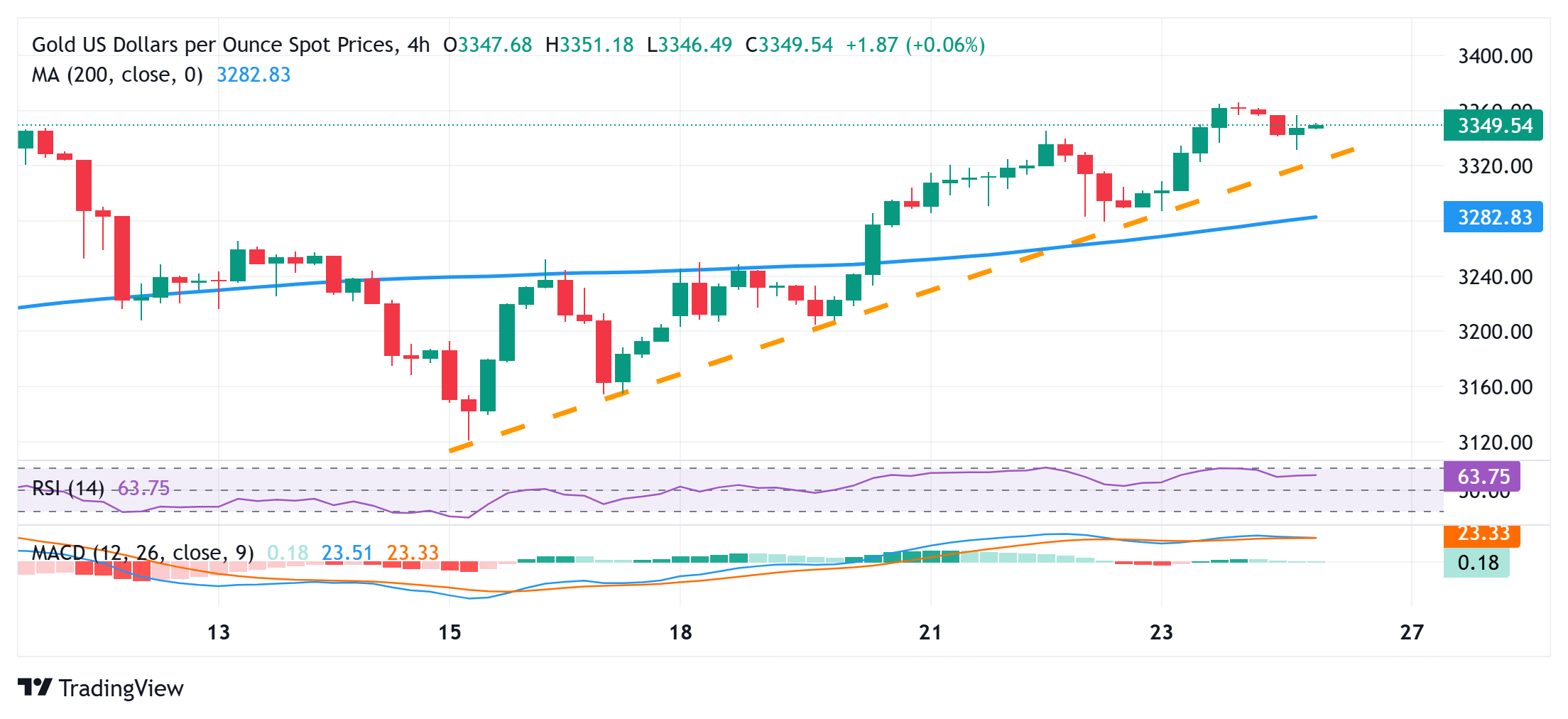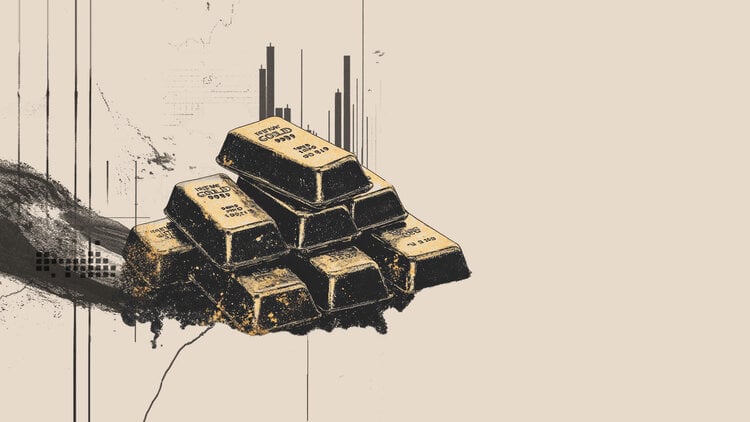- Gold price kicks off the new week on a softer note as bulls turn cautious amid trade optimism.
- US fiscal concerns and Fed rate cut bets undermine the USD, lending support to the commodity.
- Any further slide could be seen as a buying opportunity amid a bullish fundamental backdrop.
Gold price (XAU/USD) edges lower during the Asian session on Monday in reaction to US President Donald Trump’s decision to delay the implementation of tariffs on the European Union (EU). This, in turn, held back bulls from placing fresh bullish bets around the precious metal, especially after last week’s sharp rally of nearly 5%. Any meaningful corrective decline, however, seems elusive in the wake of worries over the worsening US fiscal health. This, along with bets that the Federal Reserve (Fed) will lower borrowing costs further in 2025, drags the US Dollar (USD) to a fresh monthly low and should offer support to the non-yielding yellow metal.
Apart from this, persistent geopolitical risk stemming from the protracted Russia-Ukraine war and the ongoing conflicts in the Middle East should contribute to limiting deeper losses for the Gold price. Hence, it will be prudent to wait for strong follow-through selling before confirming that the XAU/USD’s recent upward trajectory witnessed over the past week or so has run out of steam and positioning for deeper losses. Traders might also opt to wait for this week’s release of the FOMC meeting minutes and important US macro data, including the Personal Consumption Expenditure (PCE) Price Index, before positioning for the next leg of a directional move.
Daily Digest Market Movers: Gold price is undermined by trade optimism; downside potential seems limited
- In a mega U-turn, US President Donald Trump delayed the implementation of a 50% tariff on the European Union from June 1 until July 9. Earlier on Sunday Ursula von der Leyen, president of the European Commission, said that the EU was ready to move quickly in trade talks with the U.S. but needed more time to strike a deal.
- Trump’s sweeping tax cuts and spending bill, which would add an estimated $4 trillion to the federal primary deficit over the next decade, was passed in the lower house last week and will be voted on in the Senate this week. This adds to worries that the US budget deficit could worsen at a faster pace than previously expected.
- Softer-than-expected US Consumer Price Index (CPI) and the Producer Price Index (PPI) released earlier this week, along with a sluggish growth outlook, lifted bets that the Federal Reserve will eventually step in to support the economy. Traders are now pricing in at least two 25 basis points interest rate cuts by the Fed this year.
- Minneapolis Fed President Neel Kashkari said early this Monday that extended tariffs raise the risk of stagflation. The question now is a scale of stagflation, Kashkari added further. Meanwhile, the US Dollar prolongs a two-week-old downtrend and drops to a fresh monthly low, which, in turn, lends additional support to the Gold price.
- Meanwhile, Russian forces launched a massive drone and missile attack across Ukrainian cities, marking the war’s largest aerial attack to date. Trump called the attack unacceptable and said that he was considering new sanctions against Russia. Moreover, the continuous Israeli strikes on Gaza keep the geopolitical risk in play.
- The focus now shifts to FOMC minutes, due on Wednesday, which will look for cues about the rate-cut path. Traders will further confront the release of key US macro data – Durable Goods Order on Wednesday, the Prelim GDP, and the Personal Consumption Expenditure (PCE) Price Index on Thursday and Friday, respectively.
Gold price bullish technical setup backs emergence of dip-buying around $3,325

From a technical perspective, the recent move higher along an ascending trendline and positive oscillators on hourly/daily charts validates the near-term positive outlook for the Gold price. Hence, any subsequent slide is more likely to find decent support near the said trendline, currently pegged near the $3,325-3,324 region. A convincing break below, however, might prompt some technical selling and drag the XAU/USD to the $3,300 round figure en route to the $3,283 area, or the 200-period Simple Moving Average (SMA) on the 4-hour chart. The latter should act as a key pivotal point, which if broken decisively should pave the way for deeper losses.
On the flip side, momentum beyond Friday’s swing high, around the $3,366 area, will be seen as a fresh trigger for bullish traders and allow the Gold price to reclaim the $3,400 round figure. The next relevant resistance is seen near the $3,430 region, above which the XAU/USD could aim to challenge the all-time peak, around the $3,500 psychological mark touched in April, with some intermediate hurdle around the $3,465-3,470 zone.
Gold FAQs
Gold has played a key role in human’s history as it has been widely used as a store of value and medium of exchange. Currently, apart from its shine and usage for jewelry, the precious metal is widely seen as a safe-haven asset, meaning that it is considered a good investment during turbulent times. Gold is also widely seen as a hedge against inflation and against depreciating currencies as it doesn’t rely on any specific issuer or government.
Central banks are the biggest Gold holders. In their aim to support their currencies in turbulent times, central banks tend to diversify their reserves and buy Gold to improve the perceived strength of the economy and the currency. High Gold reserves can be a source of trust for a country’s solvency. Central banks added 1,136 tonnes of Gold worth around $70 billion to their reserves in 2022, according to data from the World Gold Council. This is the highest yearly purchase since records began. Central banks from emerging economies such as China, India and Turkey are quickly increasing their Gold reserves.
Gold has an inverse correlation with the US Dollar and US Treasuries, which are both major reserve and safe-haven assets. When the Dollar depreciates, Gold tends to rise, enabling investors and central banks to diversify their assets in turbulent times. Gold is also inversely correlated with risk assets. A rally in the stock market tends to weaken Gold price, while sell-offs in riskier markets tend to favor the precious metal.
The price can move due to a wide range of factors. Geopolitical instability or fears of a deep recession can quickly make Gold price escalate due to its safe-haven status. As a yield-less asset, Gold tends to rise with lower interest rates, while higher cost of money usually weighs down on the yellow metal. Still, most moves depend on how the US Dollar (USD) behaves as the asset is priced in dollars (XAU/USD). A strong Dollar tends to keep the price of Gold controlled, whereas a weaker Dollar is likely to push Gold prices up.

